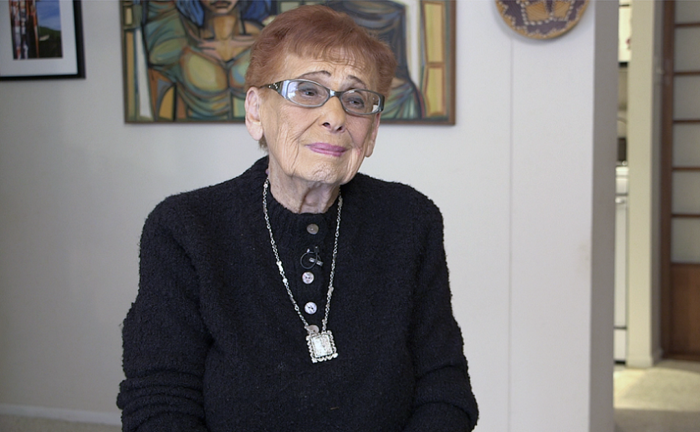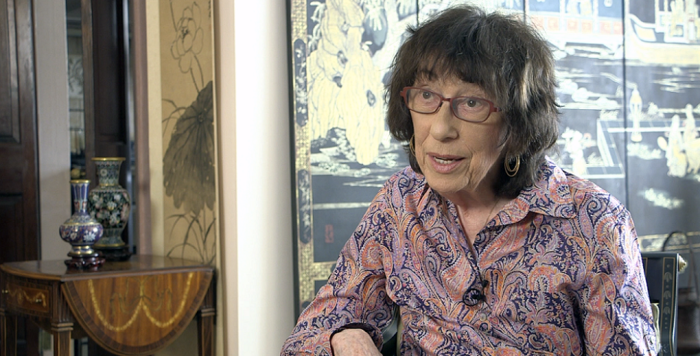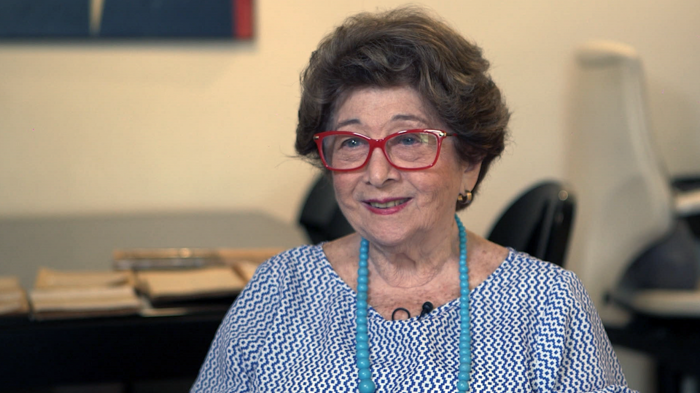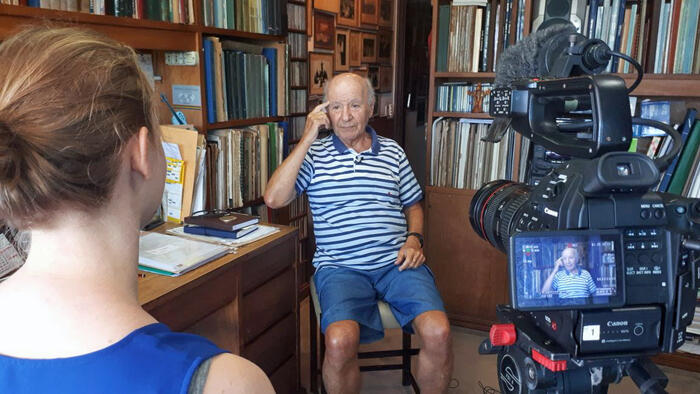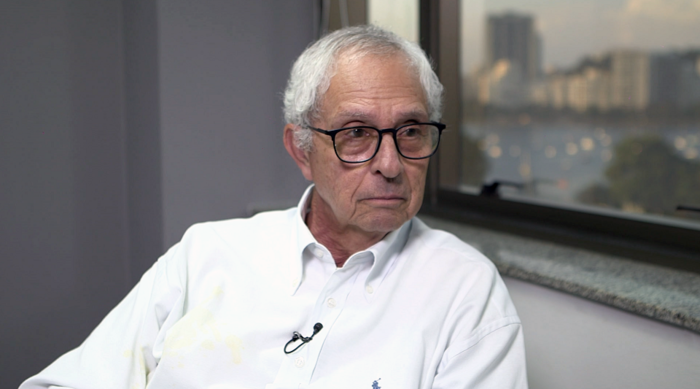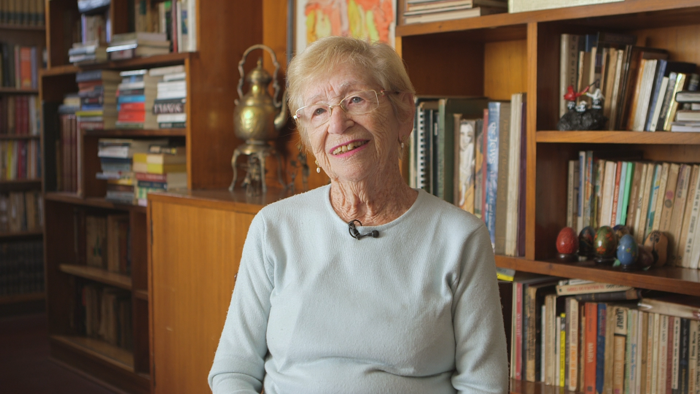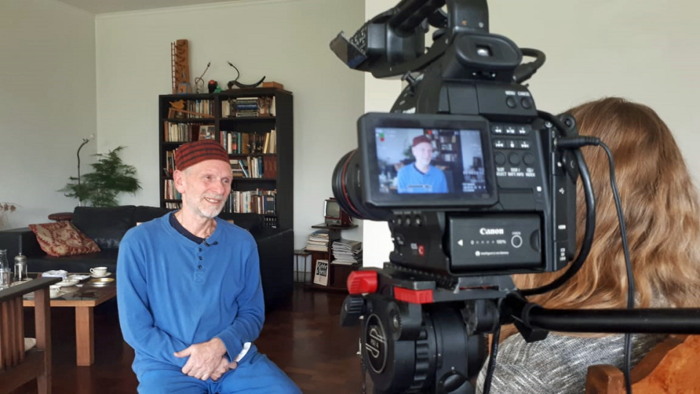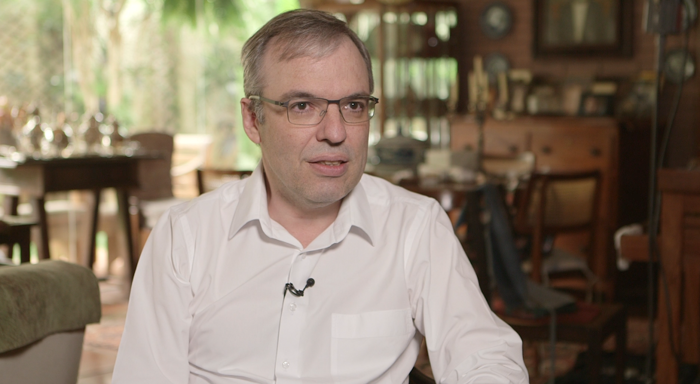2018: A Year in Review
News from the Yiddish Book Center's Wexler Oral History Project
Tayere fraynt (Dear friends),
It’s been another busy year for the Yiddish Book Center’s Wexler Oral History Project! We’ve recorded close to one hundred interviews on three continents, completed our first longer-form documentary film, and made significant headway on our NEH grant funded work on transcripts, metadata, and indices that - once completed - will provide greater access to our collection of oral history interviews. Read further to learn more about what we’ve been up to.
Christa Whitney
Director, Yiddish Book Center’s Wexler Oral History Project
Jump to a section:
Shoyn geendikt! (Done!) Beyle Film
We have put the finishing touches on BEYLE: The Artist and Her Legacy, and we are working on our press kit and publicity plan. We are excited to now be submitting the 36-minute documentary film to film festivals! Watch the trailer and read more about the film.
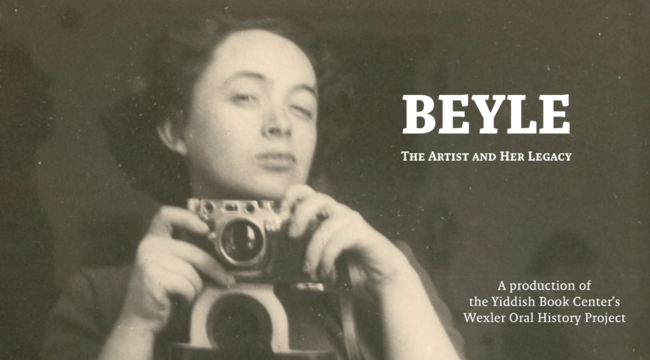
What Do People Do with Our Work? Spotlight on Newbridge on the Charles
We were thrilled to hear about how Newbridge on the Charles – a retirement community in Dedham, Massachusetts – is using our video oral history interviews as programming in its memory care and assisted living units. Bonnie Lundquist-Edes, a program specialist in assisted living at Newbridge, had been showing and discussing the oral history interviews from our website as part of a Yiddish memories program in Newbridge’s memory care unit; she is now working in the assisted living unit, and using our oral histories programming there, too! She talked about how these programs have been “revolutionary” in the engaging their senior residents. We are exploring the idea of a residency at Newbridge next year to interview some of its Yiddish-speaking residents. In the meantime, Bonnie says, “Thank you for making such a profound impact in the lives of so many.”
Gib a kuk! (Check It Out!) New On Our Website
In his interview, Pulitzer Prize─winning cartoonist and artist Jules Feiffer shared memories of an impoverished childhood in the Bronx, his time working with famed cartoonist Will Eisner, and his excitement as his own work gained renown. (This interview was conducted in English.)
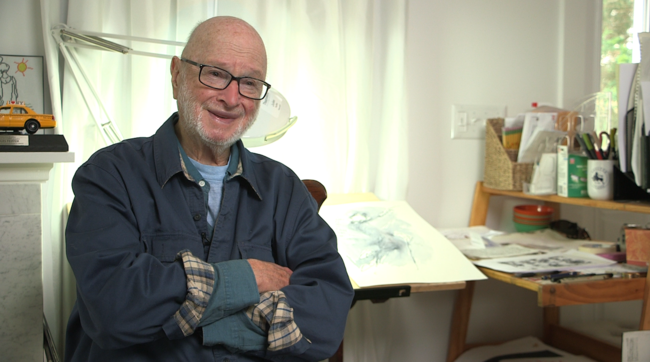
Gloria Weiner Weiss was a child actor who performed in Yiddish radio. In her oral history (conducted in English), she recalled how she tried to keep her burgeoning career a secret from everyone at school but remembers the day a teacher noticed traces of her stage makeup from the prior evening’s performance.
With a better system in place to process, translate, and subtitle segments of Yiddish interviews, we have uploaded some subtitled excerpts from older interviews.
David Fishman, scholar and author of the recently released The Book Smugglers: Partisans, Poets, and the Race to Save Jewish Treasures from the Nazis, shared stories about his friendship with Yiddish writer Chaim Grade in his 2014 interview. David told how during their long walks together, Grade would stop every few feet to argue or expound about their shared passion: Yiddish literature and philosophy.
In the interview we recorded in 2017 Naomi Leaf Halpern, age 102, remembered touring Eastern Europe as a dancer in the 1930s, and performing in the Ziegfeld Follies, and she told a funny story of her immigrant mother accidentally putting gefilte fish in the dumb waiter, thinking it was a normal cupboard.
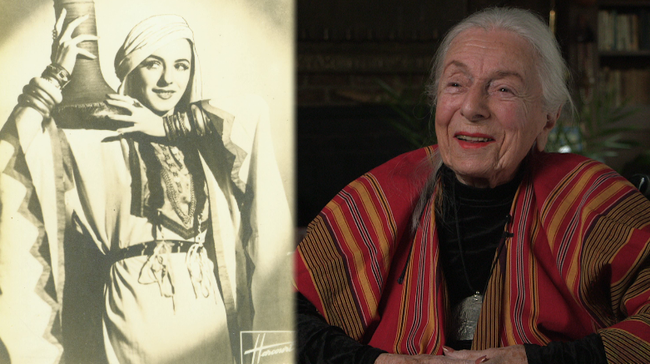
Narrative Connections: Featured Compilations from the Collection
As the archive of oral histories grows, so do the opportunities for our team to be creative! This year our editor Liz Walber, continued to curate thoughtful and entertaining web exhibits and compilations on specific topics from the collection. We closed the year with two such projects—a web exhibit and social media event on child stars of the Yiddish stage and radio, and a video compilation of Hanukkah stories.
The Yiddish child stars page was especially meaningful for Liz to edit. She was behind the camera when we interviewed Gloria Weiner Weiss, one of the former child stars. Gloria is one of Liz’s favorite narrators and one of the most delightful people she’s met through her work with the project; she has such a warm soul and a love of Yiddish and people. A running theme in the child stars project was a focus on personal archives—both Gloria and Henry Kellerman kept newspaper clippings, photos, and letters laminated and in pristine condition.
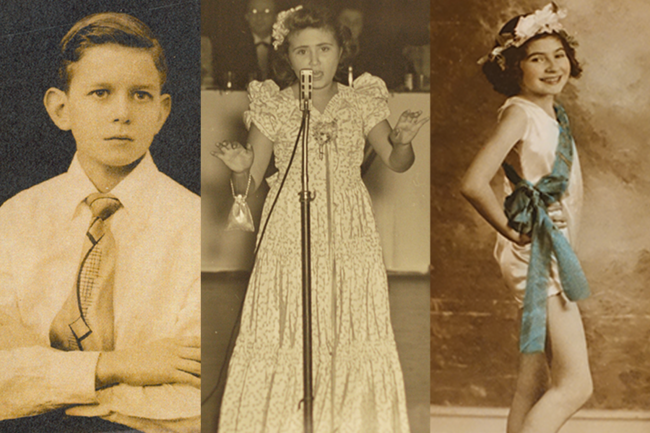
Our second year-end compilation was a fun one: an exploration into the Hanukkah stories from our collection. Hanukkah carries the complexity of having to be either a companion or a counterpoint to the Christmas season. Although Liz wanted the video to be a fun holiday compilation, she also got a chance to explore the anti-Christmas, or “Chrismukkah,” divide through the stories we picked.
Liz is looking forward to the new year and continuing our creative web-curation projects!
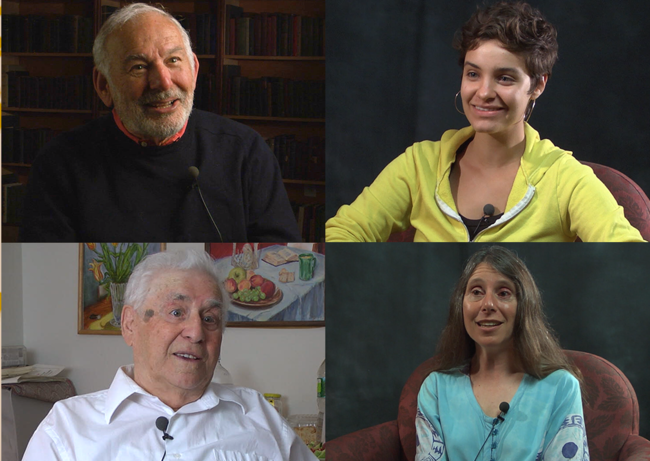
From the Editing Studio
It’s been our busiest year yet in the editing studio. In addition to two full-time staff members, we’ve had talented interns filling almost every work-station throughout the week, providing invaluable support through the initial processing, editing, and indexing of the interviews. Among our team, we’ve had interns with special language skills to help us index, translate, and subtitle interviews in Polish, Russian, and Spanish. Thanks to the diligent work of our interns and the leadership of our editor, Liz Walber, we now have over 700 interviews accessible to the public through our website.
New Member of the Wexler Oral History Project Staff
In July we welcomed Emily Densmore as our project assistant. Emily graduated from Roanoke College with a degree in creative writing. While in college Emily became interested in Yiddish literature and history, so she designed an independent study course that enabled her to pursue Yiddish studies and become the first person at her college to study Yiddish. Currently Emily is taking a Yiddish-language course with the Workmen’s Circle to improve her language skills.
Vos hert zikh epes nayes? (What’s New with the NEH Grant?)
We are entering the second half of our NEH grant-funded project: indexing and transcribing our collection to increase its accessibility. We have transcribed over 300 interviews and we have indexed almost 100 interviews. We have expanded our keywords lists to include over 350 Yiddish words, 350 names of important Yiddish figures, and over 250 Eastern European geographical location names. We have also hired some wonderful interns to index and copy edit transcripts; under the supervision of our NEH project coordinator Carole Renard, they are helping to move the project along smoothly. We are making great progress and are excited to enter into this new phase, which will include bilingual indexing, syncing transcripts, and making the work available to the public! Learn more about this work.
Fieldwork Update: Highlights from behind the Camera
From the nearly one hundred interviews we’ve recorded in the past year, a few names stand out. In April, we interviewed the American actor (and former president of the Screen Actors Guild) Ed Asner. In his interview, Ed described his youth in Kansas City, where his father owned a scrap metal business. He recalled disliking Hebrew school and dropping out of college except for the theater productions, and he even spoke a little Yiddish for us. Adding to our series of interviews with descendants of Yiddish writers, we interviewed descendants of women Yiddish writers Malka Lee, Celia Dropkin, and Kadya Molodowsky. These interviews add unique insight into the burgeoning field of scholarship into women in Yiddish literature and history. Other highlights were with the cantor Herschel Fox, who grew up in Winnipeg before getting involved in the Yiddish theater. He not only is an amazing storyteller but he also sang throughout the interview and has the uncanny ability to switch between Yiddish dialects.
Brazil Fieldwork
In May Christa Whitney spent a month in Brazil recording oral history interviews with Yiddish speakers in Rio de Janeiro and São Paulo. In Rio, our work was in partnership with Professor Sonia Kramer and the Vivir con Yidish (Live with Yiddish) initiative at the Pontificia Universidade Catolica. Christa gave talks at the Pontificia Universidade Catolica in Rio de Janeiro and the Universidade de São Paulo, and she recorded twenty-eight interviews while in Brazil.
Spotlight on Conferences
Adventures in Scandinavia
The second international fieldwork trip in the past year was built around Christa Whitney’s June presentation on our interview series with descendants of Yiddish writers at the International Oral History Association conference in Jyväskylä, Finland. Before the conference, she interviewed several Yiddish-speaking members of the small Jewish community in Helsinki. After the conference, she stopped off in Malmö, Sweden, to interview some Yiddish speakers there. She might later lead to a more comprehensive fieldwork trip to Sweden, where Yiddish has a special status and support as an official minority language.
In the past year, field fellows have also conducted twenty-three oral history interviews around the world, from Israel to Germany to upstate New York.
Connecting with Colleagues: Oral History in Montreal
In October three members of the Wexler Oral History Project team traveled to the Oral History Association conference in Montreal. Our editor Liz Walber and Christa Whitney co-presented a mini workshop on how to design and run an archival video preservation system, and Christa participated in a roundtable discussion about childhood memories in oral history. While in Montreal, we also interviewed a few people—a descendant of Yiddish writers, a descendant of Bundists who now works as a literary translator, and a painter who was part of a community of Yiddish-speaking artists in Montreal.
Liba Augenfeld, z’’l, former Jewish partisan and prominent Montreal-based Yiddish cultural activist, died on March 8. Born in Vilna in 1923, she grew up in a secular Jewish home. Her parents taught in the central Yiddish school organization (TSYSHO). During World War II, Liba joined the FPO resistance movement in the Vilna ghetto and became a partisan fighter. After meeting her husband, also a partisan, the two moved with their daughter Rivka to Montreal in 1948, where Liba worked as an activist helping to promote and preserve Yiddish culture.
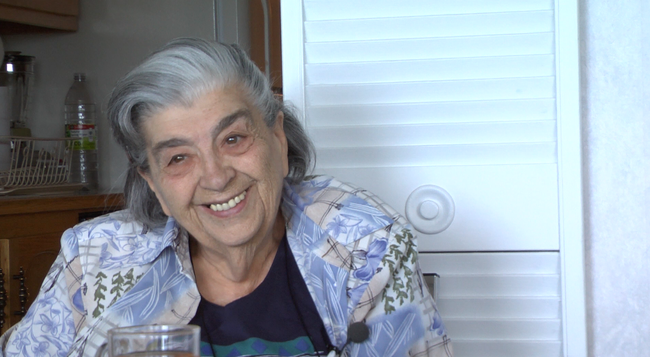
Bunny Hoffinger, z’’l, former fashion designer who grew up on the Lower East Side of Manhattan, died on July 3. Born in 1930 in Brooklyn, Bunny grew up a native Yiddish speaker and attended Unser Camp with her family in the summer. Bunny was a talented artist who become a fashion and interior designer. A longtime supporter of the Yiddish Book Center, she worked to actively preserve Yiddish culture throughout her life.
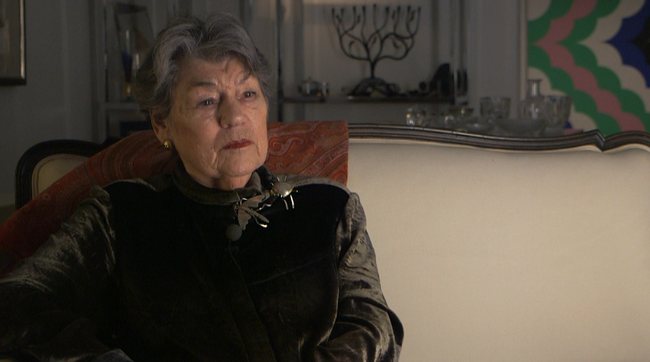
Sadie Espar, z’’l, a librarian from Detroit, Michigan, passed away on August 9. Sadie was born in 1922 in Detroit, Michigan. She grew up in an observant, Yiddish-speaking home, where her mother read her the Bintel Brief and her father taught her to write in Yiddish. In adulthood, Sadie earned her master of arts in library science and worked as a librarian for many years in Detroit before moving with her family to California. While in California, Sadie continued to be involved in the Yiddish community, eventually starting a Yiddish group at her senior home in Palo Alto, CA.
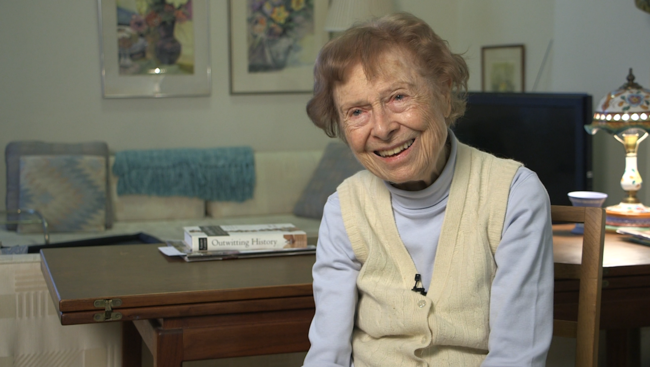
Jacob Schlitt, z’’l, New York City born native Yiddish speaker and social activist, passed away on June 22. Born in 1927 in the Bronx, Jacob’s mother instilled in him a love of Yiddish and social justice, which influenced his life’s work. Throughout his life, Jacob worked for the International Ladies’ Garment Workers Union, the Jewish Labor Committee, and the Amalgamated Laundry Workers Union, among many others, and he devoted his life to helping bettering others.
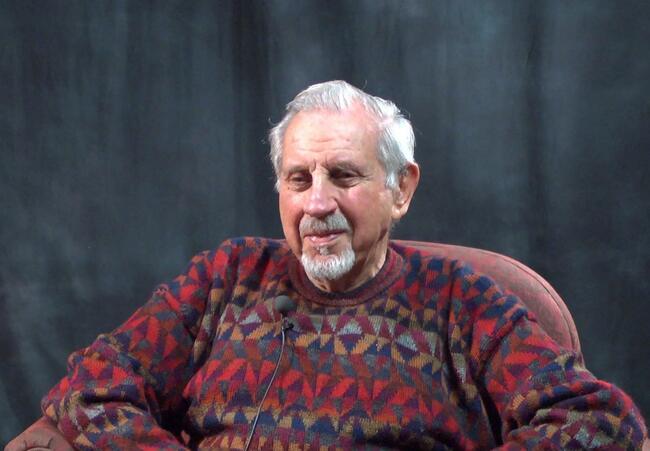
Chana Mrocki, z’’l, Yiddish and primary school teacher, passed away July 29. Born in Warsaw in 1938, her family was involved in the Jewish Labor Bund and was sent to a Siberian gulag when they wouldn’t take Soviet citizenship. Returning to Lodz, Poland, in 1945, her family home became a meeting point for postwar Jewish refugees. In 1947 her family settled in Australia, where Chana devoted her life to the preservation of Yiddish culture and the memory of those who were lost in the Holocaust. Among her many roles, she worked on the Holocaust Exhibition committee, and the Sholem Aleichem College Council, and she was actively involved with the Sotsyalistisher Kinder Farband (Socialist Children’s Union).
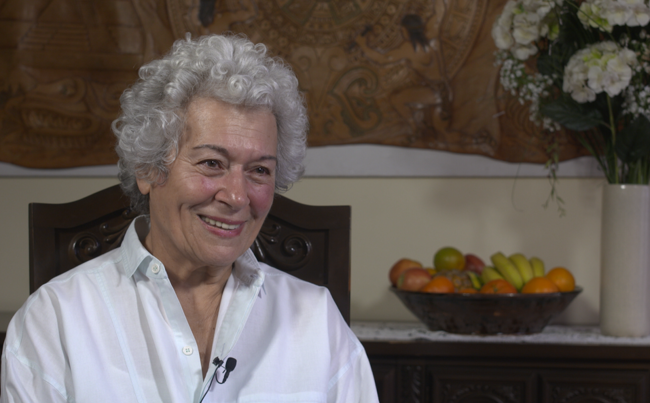
Anna Hootnick, z’’l, passed away July 30 at the age of 103. Anna was born 1915 and grew up near Blue Hill Avenue in the heart of Jewish Boston; she recalls her old neighborhood in her interview. With her gift for storytelling, Anna spoke about how her upbringing influenced her own Yiddish identity and how she passed that sense of identity on to her own beloved family.
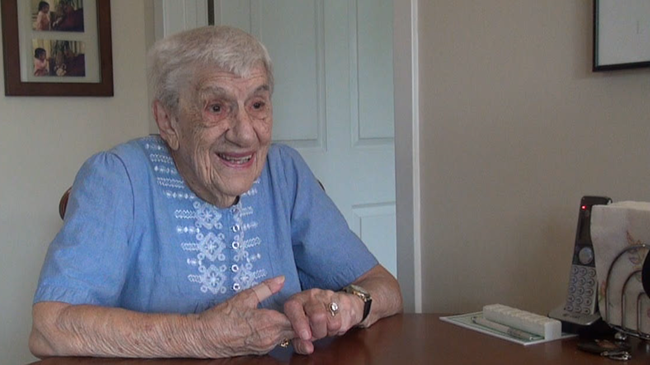
Boris Rubanovitsch, z’’l, passed away December 21. Boris was one of the Jewish soldiers who served in the Finnish army during the phase of WWII when Finland was allied with Germany. After the war he made a career in the textile business and was an active part of the Jewish community in Finland. We are greatful to have had the chance to interview him during our Scandanavian fieldwork this past summer.
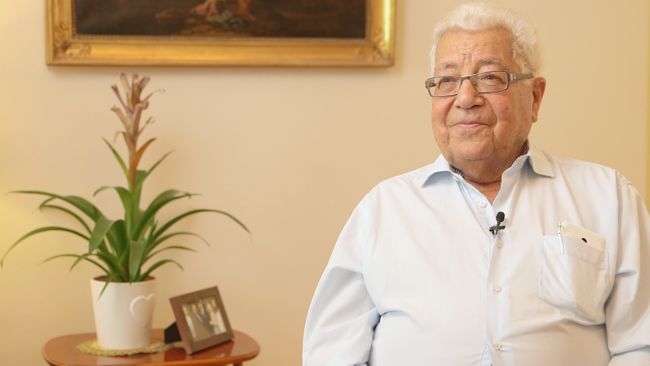
Follow us online!
Twitter: @YiddishStories
Facebook: facebook.com/WexlerOralHistoryProject
Instagram: @yiddish_stories

